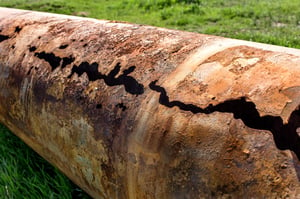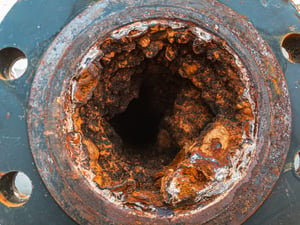When sewer systems work, they’re largely invisible to the public. Wastewater flows, unseen, through pipes from homes, businesses and industries to treatment plants, where it is cleaned and returned to the environment.
But standing pools of water and foul odor—signs a sewer is not functioning properly—are increasingly common.
Many of our sewer systems were built a century ago, when corrosion management solutions and techniques were limited. These are nearing the end of their useful lives, primarily due to corrosion. In fact, corrosion is one of the biggest issues facing underground infrastructure, according to NACE International.
 Why Sewer Erosion and Corrosion Matter
Why Sewer Erosion and Corrosion Matter
Corrosion is a particularly dangerous and costly form of pipe decay: Like cracks and breaks, it can degrade the structural integrity of a pipe and cause wastewater to leak into groundwater or waterways via exfiltration, potentially sickening people and harming the environment. New, dangerous substances can also enter the flow, and corrosive microbes and bacteria within lines can release toxic gases. Corrosion costs American drinking water and sewer utilities $80 billion per year.
What Causes Corrosion
Many factors contribute to corrosion-induced sewer system breaks, including soil conditions, seasonal temperature change and seismic action. Corrosion itself comes in a variety of forms, including uniform attack, pitting, galvanic corrosion and selective leaching. Erosion occurs when effluent running along a line wears away at the material, leaving grooves, rounded holes, gullies and general flow patterns. In many cases, failures caused by erosion occur in a relatively short period of time, according to NACE.
In the wastewater industry, corrosion is often intensified by microbes, in a process known as microbially induced corrosion, or MIC. Bacteria collect in pipes and treatment plants and produce hydrogen sulfide, a toxic, flammable, smelly, and corrosive gas. A chemical reaction transforms this into sulfuric acid, which eats away aggressively at concrete pipes. In addition, hydrogen sulfide endangers workers and the public: Exposure to this toxic gas can irritate the eyes and skin, cause difficulty breathing, and lead to coma or even death.
How to Remedy Corrosion
An effective corrosion management program is necessary to keep wastewater systems running smoothly and protect workers.
 Identify corrosion threats. Regularly inspecting lines helps identify corrosion so that steps can be taken to curb it and repair the damage it has caused.
Identify corrosion threats. Regularly inspecting lines helps identify corrosion so that steps can be taken to curb it and repair the damage it has caused.- Perform a cost analysis of mitigation measures. Compare the capital expenses required to address corrosion as well as the cost of failure, including the risk of fines and danger to workers and the public.
- Decide on the corrosion control strategies to be used. Among the techniques commonly in use are
- Cleaning sewers: Rocks, sand and other debris settle to the bottom of pipes, increasing naturally occurring bacteria in the system—including those that cause MIC. Mechanical and chemical cleaning can help reduce harmful microbes.
- Applying corrosion-inhibiting coatings or linings: Both internal and external linings can protect against corrosion and limit microbial growth.
- Replacing older lines with corrosion-resistant materials: Steel, iron and unlined concrete, which are highly susceptible to corrosion, can be replaced with PCV, vitrified clay, MIC-resistant concrete and copper pipes.
- Identifying and rehabbing pipes: Older pipes with pitting corrosion, for example, can often be repaired and relined.
There’s a “staggering” maintenance deficit in the wastewater industry, according to the 2021 Report Card for America’s Infrastructure, but your wastewater system doesn’t have to fall victim to corrosion. While there are many methods for addressing corrosion, the most effective is prevention. Regularly inspecting lines can help identify pipes in danger of corrosion, so you can take action before damage or a breakage occurs.
Verisight Pro+ pairs smart technology with the classic, rugged push camera to quickly troubleshoot corrosion and other sources of infiltration. Schedule a demo to learn more:

